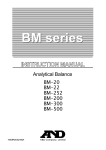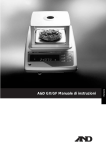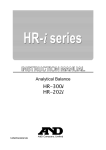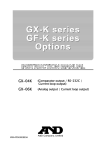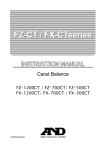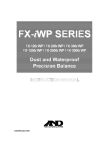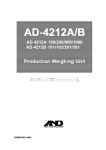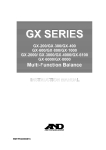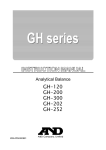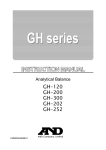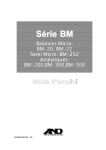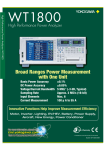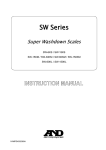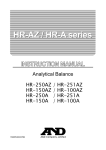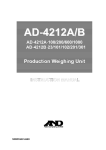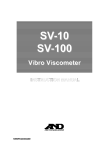Download A&D GF-10K Product specifications
Transcript
MC-10K MC-30K 1WMPD4002203A This Manual and Marks All safety messages are identified by the following, “WARNING” or “CAUTION”, of ANSI Z535.4 (American National Standard Institute: Product Safety Signs and Labels). The meanings are as follows: WARNING CAUTION A potentially hazardous situation which, if not avoided, could result in death or serious injury. A potentially hazardous situation which, if not avoided, may result in minor or moderate injury. This is a hazard alert mark. This manual is subject to change without notice at any time to improve the product. The contents of the product specifications and this manual are subject to change without any obligation on the part of the manufacturer. Under the copyright laws, the software (program) described in it are copyrighted, with all rights reserved. The software may be installed into one computer and may not be installed into other computers without the prior written consent of A&D Company. Copying includes translation into another language, reproduction, conversion, photocopy and offer or loan to another person. Microsoft, Windows, Word and Excel are registered trademarks of the Microsoft Corporation. 2012 All rights reserved. No part of this publication may be reproduced, transmitted, transcribed, or translated into any language in any form by any means without the written permission of A&D Company, Limited. Contents Basic Operation 1. Introduction ......................................................................................................... 3 1-1. About This Manual .........................................................................................................3 1-2. Features..........................................................................................................................3 1-3. Compliance.....................................................................................................................4 1-3-1. Compliance with FCC Rules ..................................................................................... 4 1-3-2. Compliance with EMC Directives.............................................................................. 4 2. 2-1. 2-2. Unpacking And Installing The Balance................................................................ 5 Auto-centering Pan (AX-MC10K/30KPAN) Installation Procedure .....................................................6 Installing the Balance .....................................................................................................7 3-1. 3-2. 3-3. 3-4. Precautions ......................................................................................................... 8 Before Use......................................................................................................................8 During Use......................................................................................................................9 After Use .........................................................................................................................9 Power Supply .............................................................................................................. 10 3. 4. Display Symbols And Key Operation ................................................................ 11 5. Weighing Units.................................................................................................. 12 6. Weighing ........................................................................................................... 14 6-1. Selecting a Weighing Unit (Mode) .............................................................................. 14 6-2. Basic Weighing............................................................................................................ 14 6-2-1. For More Stable Weighing....................................................................................... 14 6-2-2. When Using as a Mass Comparator....................................................................... 14 6-2-3. When Building into a System .................................................................................. 15 Adapting to the Environment 7. 7-1. 7-2. Weighing Speed Adjustment / Self Check Function ...................................................... 16 Weighing Speed Adjustment....................................................................................... 16 Self Check Function with Response Adjustment ....................................................... 17 8-1. 8-2. 8-3. 8-4. 8-5. 8-6. Calibration......................................................................................................... 18 Calibration Group ........................................................................................................ 18 Automatic Self Calibration........................................................................................... 19 One-Touch Calibration ................................................................................................ 20 Calibration Using an External Weight......................................................................... 21 Calibration Test Using an External Weight ................................................................. 22 Correcting the Internal Mass Value............................................................................. 23 8. Functions 9. 9-1. 9-2. Function Switch And Initialization...................................................................... 25 Permit or Inhibit............................................................................................................ 25 Initializing the Balance................................................................................................. 26 10. 10-1. 10-2. 10-3. 10-4. Function Table................................................................................................... 27 Structure and Sequence of the Function Table .......................................................... 27 Display and Operation Keys ....................................................................................... 27 Details of the Function Table....................................................................................... 28 Description of the Class "Environment, Display"........................................................ 32 Instruction manual 1 GX-K series, GF-K series 10-5. Description of the Item "Data Output Mode" .............................................................. 33 10-6. Description of the Item "Data Format" ........................................................................ 34 10-6-1. Description of the Data Format Added to the Weighing Data............................................. 36 10-7. Data Format Examples ............................................................................................... 37 11. 11-1. 11-2. ID Number And GLP Report.............................................................................. 38 Setting the ID Number................................................................................................. 38 GLP Report.................................................................................................................. 39 RS-232C Serial Interface Standard Input And Output Interface................................................................. 42 12. 12-1. RS-232C and External Contact Input ......................................................................... 42 12-2. Connection to Peripheral Equipment.......................................................................... 44 12-2-1. Connection to the AD-8121B Printer ................................................................... 44 12-2-2. Connection to a Computer and the Use of WinCT ............................................. 45 13. 13-1. 13-2. 13-3. 13-4. Commands........................................................................................................ 46 Command List ............................................................................................................. 46 Acknowledge Code and Error Codes......................................................................... 47 Control Using CTS and RTS....................................................................................... 48 Settings Related to RS-232C...................................................................................... 48 14. Extended Function ............................................................................................ 49 14-1. Description of "Averaging range" and "Averaging time" ...................................................... 50 14-1-1. Averaging Range ( f1-b ) and Averaging Time ( f1-t )...................................... 50 14-1-2. Filter Depending on Differences in the Amount to Deliver Powdery and Liquid Material........ 51 Maintenance 15. 15-1. Maintenance ..................................................................................................... 52 Treatment of the Balance............................................................................................ 52 16. 16-1. 16-2. 16-3. 16-4. Troubleshooting ................................................................................................ 53 Checking the Balance Performance and Environment.............................................. 53 Error Codes ................................................................................................................. 54 Other Display............................................................................................................... 56 Asking for Repair ......................................................................................................... 56 17. 17-1. 17-2. Specifications .................................................................................................... 57 External Dimensions ................................................................................................... 58 Options and Peripheral Instruments ........................................................................... 59 18. 18-1. 18-2. Terms/Index ...................................................................................................... 61 Terms ........................................................................................................................... 61 Index ............................................................................................................................ 63 2 1. Introduction This manual describes how the MC Series Mass Comparator Balances, MC-10K and MC-30K, work and how to get the most out of them in terms of performance. Read this manual thoroughly before using the balance and keep it at hand for future reference. For other functions and operations that this manual does not describe, refer to the GX-K series instruction manual. 1-1. About This Manual This manual consists of the following five parts: Basic operation ........................ Describes precautions, the balance's construction and basic operation. Adapting to the environment .... Describes response (and stability) adjustment to adapt to the environment where there is vibration or drafts, the way to maintain weighing precision in a variation of ambient temperature, calibration and calibration test. Selecting functions.................... Describes functions of the balance. Interface and communication ... Describes the RS-232C serial interface and external contact input. The RS-232C serial interface can communicate with a computer that requests weighing data and controls the balance. This RS-232C interface is for use with a computer or printer. The external contact input commands the balance re-zeroing and data output. Maintenance ............................ Describes maintenance, error codes, troubleshooting, specifications and options. 1-2. Features Display resolution, one digit greater than a standard balance. This allows management of OIML class F1 or lower weights. Capable of weighing small amounts of powdery or liquid material, even with a massive tare. When used as a mass comparator, the balance can achieve even more precise weighing, by using the optional auto-centering pan (sold separately), which reduces eccentric loading errors. 3 1-3. 1-3-1. Compliance Compliance with FCC Rules Please note that this equipment generates, uses and can radiate radio frequency energy. This equipment has been tested and has been found to comply with the limits of a Class A computing device pursuant to Subpart J of Part 15 of FCC rules. These rules are designed to provide reasonable protection against interference when equipment is operated in a commercial environment. If this unit is operated in a residential area, it may cause some interference and under these circumstances the user would be required to take, at his own expense, whatever measures are necessary to eliminate the interference. (FCC = Federal Communications Commission in the U.S.A.) 1-3-2. Compliance with EMC Directives This device features radio interference suppression and safety regulation in compliance with the following Council Directives Council directive 89/336/EEC EN61326 EMC directive Council directive 73/23/EEC EN60950 Safety of Information Technology Equipment The CE mark is an official mandatory European marking. Please note that any electronic product must comply with local laws and regulations when sold or used anywhere outside Europe. 4 2. Unpacking And Installing The Balance The balance is a precision instrument. Unpack the balance carefully. Keep the packing material to be used for transporting the balance in the future. The packing contents depend on the balance model. See the illustrations to confirm that everything is contained. Weighing pan Pan support Handling hole A clear display cover Bubble spirit level Display Keys Reference card Leveling foot Draft gate Remove the gate when cleaning. RS-232C and external terminals Note Terminal cover Cover the terminal or connect the waterproof RS-232C cable (GX-07K) to keep waterproof and dustproof. AC adapter jack Grounding terminal Note AC adapter plug Insert the plug into the jack firmly. The connection is tight to keep waterproof and dustproof. Position of placing AC adapter labels AC adapter plug Note Please confirm that the AC adapter type is correct for your local voltage and receptacle type. AC Adapter Breeze break Windows communication tools software 5 AC adapter labels 2-1. Auto-centering Pan (AX-MC10K/30KPAN) Installation Procedure Caution: During installation, do not to apply excessive force to the balance. When used as a mass comparator, the balance can achieve even more precise weighing, by using the auto-centering pan (sold separately), which reduces eccentric loading errors. 1. Place the pan support on the balance. Place the breeze break provided with the AX-MC10K/30KPAN option on the balance. Place the auto-centering pan guide on the pan support, and then place the auto-centering pan on the auto-centering pan guide. Auto-centering pan Auto-centering pan guide Option AX-MC10K/30KPAN breeze break Pan support Note When replacing the weighing pan with the auto-centering pan, be sure to calibrate the balance before weighing. Refer to “8. Calibration”. 6 2-2. Installing the Balance Install the balance as follows: 1 Refer to "3. Precautions" for installing the balance. Bubble spirit level 2 Install the pan support, weighing pan and draft gate. Refer to the previous page. Good 3 Adjust the leveling feet to level the balance. Confirm it using the bubble spirit level. 4 Confirm that the AC adapter type is correct for the local voltage and power receptacle type. 5 Connect the AC adapter to the balance firmly. Earth the balance. Warm up the balance for at least 30 minutes with nothing on the weighing pan. No good Leveling foot 7 Grounding (Earth) To AC adapter 3. Precautions To get the optimum performance from the balance and acquire accurate weighing data, note the following: 3-1. Before Use The maximum resolution of the precision balance is ten million counts. Therefore, there are tendencies to be influenced by temperature change, air pressure change, static electrisity, vibration and drafts where the balance is placed. Install the balance in an environment where the temperature and humidity are not excessive. The best operating temperature is about 20°C / 68°F at about 50% relative humidity. Install the balance where it is not exposed to direct sunlight and it is not affected by heaters or air conditioners. Install the balance where it is free of dust. Install the balance away from equipment that produces magnetic fields. Install the balance in a stable place avoiding vibration and shock. Corners of rooms on the first floor are best, as they are less prone to vibration. The weighing table should be solid and free from vibration, drafts and as level as possible. Level the balance by adjusting the leveling feet and confirm it using the bubble spirit level. If static electricity is a problem at the installation site, use the electrostatic field meter and the static eliminator. Ensure a stable power source when using the AC adapter. Connect the AC adapter and warm up the balance for at least 30 minutes. Calibrate the balance periodically for accurate weighing. When the balance is installed for the first time or has been moved, warm up the balance for at least 6 hours to allow the balance to reach equilibrium with the ambient temperature, and then perform calibration before use. The meaning of IP-65 is "No ingress of dust. Projected against water jets". If a powerful water jet is used or the balance is immersed in water, it may cause a damage that is due to ingress of water. Confirm that "the plug is inserted firmly into the jack" and "the terminal is covered using the waterproof cover or the waterproof RS-232C cable (GX-07K)", when using the balance. Use the waterproof option cable GX-07K, when the RS-232C interface is used with IP-65. AX-KO1710-200, a standard RS-232C cable, is not waterproof or dustproof. Confirm that the weighing pan does not touch to rim. Do not install the balance where flammable or corrosive gas is present. 8 3-2. During Use Discharge static electricity from the weighing material. When Material case Charged weighing sample (plastics, insulator, etc.) could have a static sample charge, the weighing value is influenced. Ground the balance, and Eliminate the static electricity by using an optinal static eliminator, AD-1683. Grounding Or try to keep the ambient humidity above 45%RH at the room. Or use the metal shield case. Or wipe a charged material (plastic sample etc.) with the wet cloth. This balance uses a strong magnet as part of the balance assembly, so please use caution when weighing magnetic Magnetic materials such as iron. If there is a problem, use the underhook on material the bottom of the balance to suspend the material away from the influence of the magnet. Draft Eliminate any temperature difference between the sample and the 20°C 40°C environment. When a sample is warmer (cooler) than the ambient temperature, the sample will be lighter (heavier) than the true Weighing Pan weight. This error is due to a rising (falling) draft around the sample. Make each weighing gently and quickly to avoid errors due to changes in the environmental conditions. Shock Do not drop things upon the weighing pan, or place a sample on the pan that is beyond the balance weighing capacity. Place the sample in the center of the weighing pan. Do not use a sharp instrument such as a pencil to press the keys. Use your finger only. Press the RE-ZERO possible errors. key before each weighing to prevent Calibrate the balance periodically so as to eliminate possible errors. Take into consideration the affect of air buoyancy on a sample when more accuracy is required. It is possible to check the reference card for principle operation. Prevent foreign matter, such as powder, liquid and metal, from invading the area around the weighing pan. Use the "breeze break" for a precision weighing. 3-3. After Use Avoid mechanical shock to the balance. Do not disassemble the balance. Contact the local A&D dealer if the balance needs service or repair. Do not use organic solvents to clean the balance. Clean the balance with a lint free cloth that is moistened with warm water and a mild detergent. 9 Do not allow the balance to be immersed in water. Even though the balance complies with IP code, the balance will not withstand being completely immersed in water. The weighing pan, pan support and draft gate can be removed to clean the balance. Clean by splashing with water. Use the waterproof option RS-232C cable GX-07K, when RS-232C interface is used with IP-65. AX-KO1710-200, a standard RS-232C cable, is not waterproof or dustproof. 3-4. Power Supply Do not remove the AC adapter while the internal mass is in motion, for example, right after the AC adapter is connected, or during calibration using the internal mass. If the AC adapter is removed under the conditions described above, the internal mass will be left unsecured, that may cause mechanical damage when the balance is moved. Before removing the AC adapter, press the ON:OFF key and confirm that zero is displayed. When the AC adapter is connected, the balance is in the standby mode if the standby indicator is on. This is a normal state and does not harm the balance. For accurate weighing, keep the AC adapter connected to the balance and AC power unless the balance is not to be used for a long period of time. 10 4. Display Symbols And Key Operation Key Operations Key operation affects how the balance functions. The basic key operations are: "Press and release the key immediately" or "Press the key" = normal key operation during measurement "Press and hold the key". Displays the highest-order digit when placing a load of 10 kg or more on the MC-10K Display Displays memory data information Displays the weighing data relative to the weighing capacity in percentage, in weighing mode. (Capacity indicator) Weighing speed indicator (Response indicator) NET indicator Animal mode indicator Processing indicator Comparator indicators Stabilization indicator Units Standby indicator of power supply Interval memory Standby indicator The current data number Weighing data or stored data Processing indicator Prior notice indicator of automatic self calibration Blinking indicators Interval memory, active indicator Each key, when pressed or when pressed and held, functions as follows: Key When pressed and released When pressed and held Turns the display ON and OFF. The standby indicator is displayed when the display is turned off. The weighing mode is enabled when the display is turned on. This key is available anytime. Pressing the key during operation will interrupt the operation and turn the display OFF. In the weighing mode, turns the minimum weighing value ON and OFF. Enters the function table mode. Refer to "10. Function Table". In the counting or percent mode, enters the sampling mode. No function at the factory setting. Performs weighing speed adjustment Switches the weighing units when units other (response adjustment) and self check. than “g” are stored in the function setting. Performs calibration using the internal Displays other items of the calibration mass. menu. No function at the factory setting. Stores the weighing data in memory or By changing the function table: outputs to a printer or personal computer Outputs "Title block" and "End block" for depending on the function table settings. GLP report. Refer to "11-2. GLP Report ". (Factory setting = output) Displays the data memory menu. Sets the display to zero. 11 5. Weighing Units With the balance, only the unit “g” (gram) was set at the factory. The following weighing units and weighing modes are available for selection: Counting mode g kg DS Percent mode % OZ OZt pcs MS t TL GN ct dwt mom Density mode (To select this mode, press the MODE key until the processing indictor blinks with the unit "g" displayed. " " appears only when the density value is displayed. For details about this mode, refer to the GX-K instruction manual "15. Density Measurement".) Programmable-unit. (No unit displayed. For details, refer to the GX-K instruction manual "14. Programmable Units".) A unit or mode can be selected and stored in the function table as described in the GX-K series instruction manual "5-2. Changing the Units". If a weighing mode (or unit of weight) has been turned off, that mode or unit will be missing in the sequence. Tael has four varieties, one of which can be selected and installed at the factory. For details about the units and modes, see the table below: Name (unit, mode) Gram Kilogram Counting mode Percent mode Ounce (Avoir) Troy Ounce Metric Carat Momme Pennyweight Grain (UK) Tael (HK general, Singapore) Tael (HK jewelry) Tael (Taiwan) Tael (China) Tola (India) Messghal Density mode Programmable-unit (Multi-unit) Abbreviation g kg pcs % OZ OZt ct mom dwt Display pcs GN TL t MS DS Mlt Function table (Storing mode) is used to show the density - 12 Conversion factor 1g= 1g 1000 g 28.349523125 g 31.1034768 g 0.2 g 3.75 g 1.55517384 g 0.06479891 g 37.7994 g 37.429 g 37.5 g 31.25 g 11.6638038 g 4.6875 g - The tables below indicate the weighing capacity and the minimum display for each unit, depending on the balance model. When a measurement unit other than gram is used, it is not possible to weight up to capacity of the balance because the display does not have sufficient digits. Use the MC series balance within the values shown in the tables below. MC-10K Unit Gram Kilogram Ounce (Avoir) Troy Ounce Metric Carat Momme Pennyweight Grain (UK) Tael (HK general, Singapore) Tael (HK jewelry) Tael (Taiwan) Tael (China) Tola (India) Messghal Capacity 10100 g 10.1 kg 197 OZ 199 OZt 19500 ct 1973 mom 6494 dwt 155866 GN 198 TL 195 TL 194 TL 198 TL 865 t 1984 MS Gram 10100 10100 5600 6200 3900 7400 10100 10100 7500 7300 7300 6200 10100 9300 g g g g g g g g g g g g g g Minimum display 0.001 0.000001 0.00005 0.00005 0.005 0.0005 0.001 0.02 0.00005 0.00005 0.00005 0.00005 0.0001 0.0005 MC-30K Unit Gram Kilogram Ounce (Avoir) Troy Ounce Metric Carat Momme Pennyweight Grain (UK) Tael (HK general, Singapore) Tael (HK jewelry) Tael (Taiwan) Tael (China) Tola (India) Messghal Capacity 31000 g 31.0 kg 1093 OZ 966 OZt 155000 ct 8266 mom 1933 dwt 478403 GN 820 TL 828 TL 826 TL 992 TL 2657 t 6613 MS 13 Gram 31000 31000 31000 31000 31000 31000 31000 31000 31000 31000 31000 31000 31000 31000 g g g g g g g g g g g g g g Minimum display 0.01 0.00001 0.0005 0.0005 0.05 0.005 0.01 0.2 0.0005 0.0005 0.0005 0.0005 0.001 0.005 6. Weighing 6-1. Selecting a Weighing Unit (Mode) Press the MODE key to select a unit or mode for weighing. The unit “g” (gram) was set at the factory. To use other units, select and store units and displaying order in the function setting of “ Unit ”. For details on weighing unit storing procedure, refer to the GX-K series instruction manual, “5-2. Chaning the Units”. 6-2. 6-2-1. Basic Weighing For More Stable Weighing z To reduce the influence of drafts and vibration, set the following function settings as below. “Condition ( Cond )” of “Environment, Display ( ba5fnc )” to “Slow ( 2 )” “Filter ( f1l )” of “Environment, Display ( ba5fnc )” to “Used (1 )” Function Settings Refer to “10. Function Table” on page 27 to check or change the function settings. Class Item and Parameter ba5fnc Cond Condition 2 Environment f1l Filter 1 Display 6-2-2. Description Slow response rate, stable value SLOW Used When Using as a Mass Comparator z To avoid eccentric loading errors, place the sample in the center of the weighing pan. As an option, AX-MC10K/30KPAN auto-centering pan is available. Using an AD-8922A remote controller, which is sold separately, the balance can be controlled remotely by the AD-8922A key operations in the same way as when the CAL or RE-ZERO key of the balance is pressed. For the connection procedure between the balance and the AD-8922A, refer to the AD-8922A instruction manual. z Take measures against causes of weighing error at the installation site, such as changes in temperature, atmospheric pressure, drafts, vibration and static electricity. Perform weighing operations in an stable environment. z The table below lists the weight class and recommended measuring range for each model of the MC series. The measuring range is determined so that the balance repeatability is to be less than one third of the maximum permissible error for each weight class. 14 Weight class and recommended measuring range Weight (Displayed value) Model Class 20 kg 10 kg 5 kg 2 kg 1 kg 500 g 200 g 100 g 50 g MC-10K MC-30K F1 F2 M1 M2 F1 F2 M1 M2 F1 6-2-3. F2 M1 M2 When Building into a System z When a special weighing pan is to be designed, the weight of the pan and the material to be weighed should not exceed the weighing capacity of the balance. To reduce influences of static electricity and magnetism, use materials other than resin and magnetic material such as iron. z When a special weighing pan is to be designed, the weight of the pan and the material to be weighed should not exceed the weighing capacity of the balance. To reduce influences of static electricity and magnetism, use materials other than resin and magnetic material such as iron. z There is a function available to maintain the previous weight value in non-volatile memory, even if the AC adapter is removed. When “Zero upon power-on ( p-tr )” of “Environment, Display ( ba5fnc )” is set to “ 1 ”, the previous weight value is displayed upon power-on. For details, refer to “Zero upon power-on” on page 32. z There is a function available to perform span calibration only, when performing calibration with a tare on the weighing pan. When “Span calibration ( 5pn )” of “Environment, Display ( ba5fnc )” is set to “ 1 ”, span calibration using the internal mass is performed, with a tare on the weighing pan. For details, refer to “Span calibration” on page 32. z To set a higher response rate (weighing speed) or to batch-weigh small amounts of material, such as a powdery material, refer to “14. Extended Function”. 15 7. Weighing Speed Adjustment / Self Check Function 7-1. Weighing Speed Adjustment This function detects the influence on weighing that is caused by drafts and/or vibration at the place where the balance is installed and sets the following three weighing speeds (response characteristics) automatically. Weighing speeds 0.000 The function has three rates as follows: g Changing the weighing speed changes the display refresh rate. Indicator FAST MID. SLOW Parameter Weighing Speed Stability Display refresh rate Cond 0 Fast response, Sensitive value If the weighing speed is changed as follows: MID. or SLOW FAST =10 times/second Cond 1 Slow response, Stable value FAST MID. or SLOW = 5 times/second Cond 2 Press and hold Step 1 Press and hold the MODE key until RESPONSE is displayed. And then, press the MODE key again quickly. Release Press again Step 2 Press the MODE key to select a weighing speed. Either FAST , MID. or SLOW can be selected. Select a parameter with pressing it. Release and wait Step 3 After a few seconds of inactivity the balance displays end . Then, it returns to the weighing mode and displays the end updated response indicator. The response indicator remains displayed for a while. 0.000 g Note The weighing speed adjustment can be changed at "Condition (Cond)" of "Environment, Display (ba5fnc)" in the function table. Refer to "10. Function Table" for details. To set a refresh rate of 5 times/second when the response rate is FAST or 10 times/second when the response rate is MID. or SLOW , change the "Display refresh rate (5pd)" parameter of "Environment, Display (ba5fnc)" in the function table. If the weight value is not stabilized due to drafts or vibration when “Cond 0 ” is selected by the automatic response adjustment, change the parameter of “Cond ” manually in the function table. 16 7-2. Self Check Function with Response Adjustment This function automatically updates the response adjustment by analyzing the influence of the environment on the weighing data and also self-checks the balance performance using the internal mass. Press and hold Step 1 Press and hold the MODE key until RESPONSE is displayed, and then release the key. Step 2 The balance automatically starts to check the balance performance and sets the response characteristic. Caution Do not allow vibration or drafts to affect the balance during adjustment. Release CH . . . . Result Step 3 After automatic adjustment, the balance displays the updated response indicator and returns to the weighing mode. The response indicator remains displayed for a while. CH 0.000 g Example of display MID. and OK : The example above indicates that the result of the self check is good and MID. is selected as the response rate.. Note If improper performance is found in the self check, the balance displays CH no . Contact the local A&D dealer for repair. If the automatic response adjustment fails, the balance displays CH ng . Check the ambient conditions such as breeze and vibration, also check the weighing pan. Then, perform the adjustment again. To return to the weighing mode, press the CAL key. 17 8. Calibration 8-1. Calibration Group The balance has the following modes as a calibration group. Calibration Automatic self calibration (Calibration due to changes in temperature) Calibration using the internal mass (One-touch calibration) Calibration using an external weight Calibration Test Calibration test using an external weight (Calibration test does not perform calibration) Correction of the internal mass value Terms The following terms are defined as follows: Internal mass = Built-in calibration weight External weight = A weight that you have. Referred to as a calibration weight when used for calibration. Calibration weight = A weight used for calibration Target weight = An external weight used for calibration test Caution Calibration adjusts the balance for accurate weighing. Besides periodic calibration and before each use, perform calibration when: The balance is installed for the first time. The balance has been moved. The ambient environment has changed. Do not allow vibration or drafts to affect the balance during calibration. To output the data for GLP using the RS-232C interface, set "GLP output (info)" of "Data output (dout)". Refer to "10. Function Table". Time and date can be added to the GLP report. If the time or date is not correct, adjust them. Refer to the GX-K series instruction manual "10-7. Clock and Calendar Function". Calibration test is available only when "GLP output (info)" of "Data output ( dout )" is set to "1" or "2", The calibration and calibration test data can be stored in memory. To store them, set "Data memory (data)" to "3". Refer to the GX-K series instruction manual "12. Data Memory" for details. The value of the internal mass may change due to aging, corrosion or other damage caused by the operating environment. Check the internal mass periodically. Correct the internal mass value as necessary. 18 Caution on using an external weight The accuracy of an external weight can influence the accuracy of weighing. Select an appropriate weight as listed below: Select a mass for calibration and calibration test from the following table. Model Usable calibration weight Adjustable range MC-10K 2 kg, 3 kg, 4 kg, 5 kg, 6 kg, 7 kg, 8 kg, 9 kg, 10 kg -0.150 g ~ +0.159 g MC-30K 20 kg, 30 kg -1.50 g ~ +1.59 g The calibration weight in bold type: factory setting The calibration weight value can be adjusted within the range above. Display 8-2. This indicator means "In process of measuring calibration data". Do not allow vibration or drafts to affect the balance while the indicator is displayed. Automatic Self Calibration Automatic self calibration due to changes in temperature This function automatically calibrates the balance when the balance detects an ambient temperature change. If GLP output is selected in the function table, the balance outputs the calibration report or stores the data in memory. Automatic self calibration functions even if the display is turned off (standby state). Refer to "9-1. Permit Or Inhibit" for the operation. Caution If something is on the weighing pan, the balance judges that it is in use and does not perform automatic self calibration. To maintain the calibrated state, keep the weighing pan clear while not in use. Indicates that the balance detects a change in ambient temperature and automatic self calibration will start. If the balance is not used for a few minutes with this indicator blinking, the balance performs automatic self calibration. The blinking duration depends on the environment. Note Indicates that the balance is measuring calibration data. Do not allow vibration or drafts to affect the balance while this indicator is displayed. After calibration, the balance returns to indicate the previous display. The balance can be used while the indicator blinks. But, it is recommended that to maintain the accuracy, stop using the balance and confirm that there is nothing on the pan and allow the balance to perform self calibration. 19 8-3. One-Touch Calibration Calibration using the internal mass This function calibrates the balance using the internal mass. The only operation required is to press the CAL key. Step 1 Connect the AC adapter and warm up the balance for at least 30 minutes with nothing on the weighing pan. Step 2 Press the CAL key. Step 3 The balance displays Calin and performs calibration using the internal mass. Do not allow vibration or drafts to affect the balance. Step 4 The balance displays end after calibration. If the "GLP output (info)" parameter of the function table is set to "1" or "2", the balance displays glp and outputs the "calibration report" using the RS-232C interface or stores the data in memory. Refer to "11-2. GLP Report" and "Data memory (data)" of the function table for details. Step 5 The balance will automatically return to the weighing mode after calibration. About the internal mass The value of the internal mass may change due to aging, corrosion or other damage caused by the operating environment. Check the internal mass periodically. Correct the internal mass value as necessary. Refer to "8-6. Correcting the Internal Mass Value". To maintain the weighing accuracy, perform the calibration using an external weight periodically, as described below. 20 8-4. Calibration Using an External Weight This function calibrates the balance using an external weight. When the MC-10K is used 0.000 g Step 1 Connect the AC adapter and warm up the balance for at Press and hold least 30 minutes with nothing on the weighing pan. Step 2 Press and hold the CAL key until Calout Calout is displayed, then release the key. Release Step 3 The balance displays Cal 0 . Press Cal 0 If you want to change the calibration weight, press the SAMPLE key and go to step 4. 1 0000.000 g If you use the calibration weight value stored in the balance, go to step 5. Select Step 4 Specify the calibration weight value as follows: SAMPLE key... To switch between the calibration weight 2000.000 g selection mode (All of the digits blinking) or the value adjustment mode (The selected digits blinking). 2000.000 g With the MC-10K, the digits in the 1st, 2nd, and 3rd decimal places can be adjusted. With the MC-31K, the digits in the 1st and 2000.120 g 2nd decimal places can be adjusted. RE-ZERO key .. To select the calibration weight (All of the digits blinking) or adjust the value (The 2000.120 g selected digits blinking). Refer to page 19. PRINT key ...... To store the new weight value. Even if the AC adapter is removed, the data is 2000.123 g maintained in non-volatile memory. CAL key ......... To cancel the operation and return to Cal 0 . Cal 0 Step 5 Confirm that there is nothing on the pan and 2 press the PRINT key. The balance measures Example: the zero point. Do not allow vibration or drafts to New weight affect the balance. The balance displays the 2000.123 g calibration weight value. Place weight Step 6 Place the displayed calibration weight on the pan and press the PRINT key. The balance measures the calibration weight. Do not allow end vibration or drafts to affect the balance. Step 7 The balance displays end . Remove the weight from the pan. Remove Step 8 If the "GLP output (info)" parameter, of the function table, is set to "1" or "2", the balance displays glp and glp GLP output outputs the "Calibration Report" using the RS-232C interface or stores the data in memory. For details on the end calibration report format, refer to "11-2. GLP Report". Step 9 The balance will automatically return to the weighing mode. 0.000 Step 10 Place the calibration weight on the pan and confirm that the value displayed is within ±20 digits of the specified value. If it is not within the range, check the ambient conditions such as breeze and vibration also check the weighing pan. Then, repeat steps 1 to 10. 21 k g 8-5. Calibration Test Using an External Weight This function tests the weighing accuracy using an external weight and outputs the result. This is available only when the "GLP output (info)" parameter is set to "1" or "2". (Calibration test does not perform calibration) When the MC-10K is used 0.000 g Press and hold Cal in CC out Release Step 1 Connect the AC adapter and warm up the balance CC 0 Press for at least 30 minutes with nothing on the weighing 1 pan. 0000.000 g Step 2 Press and hold the CAL key until CCout is Select displayed, then release the key. Step 3 The balance displays CC 0 . 2000.000 g If you want to change the target weight, press the SAMPLE key and go to step 4. A list of usable weights is shown on page 19. If you use the target weight value stored in 2000.000 g the balance, go to step 5. Step 4 Specify the target weight value as follows: SAMPLE key... To switch between the target weight 2000.120 g selection mode (All of the digits blinking) or the value adjustment mode (The selected digits blinking). 2000.120 g With the MC-10K, the digits in the 1st, 2nd, rd and 3 decimal places can be adjusted. With the MC-31K, the digits in the 1st and 2nd 2000.123 g decimal places can be adjusted. . CC 0 RE-ZERO key To select the target weight (All of the digits blinking) or adjust the value (The selected 0.000 digits blinking). Refer to page 19. Example: PRINT key ...... To store the new weight value. Even if the New weight 2 k 2000.123 g AC adapter is removed, the data is maintained in non-volatile memory. ......... CAL key To cancel the operation and return to CC 0 . Place weight Step 5 Confirm that there is nothing on the pan and press the PRINT key. The balance measures the zero point and displays the measured value. Do not allow vibration or drafts to affect the 2 balance. The balance displays the target weight value. Step 6 Place the displayed target weight on the pan and press the 2000.123 PRINT key. The balance measures the target weight and displays the measured value. Do not allow vibration or end drafts to affect the balance. Step 7 The balance displays end . Remove Remove the weight from the pan. Step 8 The balance displays glp and outputs the glp "calibration test report" using the RS-232C interface GLP output or stores the calibration test data in memory. Refer to end "11-2. GLP Report" of the function table for details. Step 9 The balance will automatically return to the weighing mode. 0.000 22 g k g g 8-6. Correcting the Internal Mass Value The balance can correct the internal mass value within the range shown below. This function corrects the internal mass value to conform to an external weight. The corrected mass value is maintained in non-volatile memory even if the AC adapter is removed. The internal mass value is corrected as follows: The same mass 10 kg 10 kg Model Target Range Correction the internal mass by +0.30 g at 10 kg. MC-10K 2 kg ±0.500 g Calibrate with the 10000. 0 0 g MC-30K 10 kg ±5.00 g 10000.30 g corrected internal mass. Corrected external weight Step 1 Calibrate the balance using the internal mass. (one-touch calibration). Place the external weight and find out the correction value. Example for correcting the weight value by +0.30 g in 10 kg, when using MC-30K. If correcting the weight value by +0.30 g in 5 kg, the weight changed into 10 kg, the correction value is +0.60 g. Step 2 Press the ON:OFF key to turn off the display. Step 3 While pressing and holding the PRINT key and the SAMPLE key, press the ON:OFF key. The balance displays p5 . With these keys Press the key held down p5 Step 4 Press the PRINT key. Then the balance displays the function switches. Set the function table switch and internal mass correction switch to "1" as shown above using the following keys. a-01111 SAMPLE key ...To select the switch to change the value. The selected digit blinks. RE-ZERO key ..To change the parameter of the switch selected. a-1x x x 1 Function table switch Correction switch of internal mass Step 5 Press the PRINT key to store the new setting. The balance returns to the weighing mode. Step 6 Press and hold the SAMPLE key to enter the function table and release the key when ba5fnc is displayed. Step 7 Press the SAMPLE key several times until C5 in is displayed, then release the key. Step 8 Press the PRINT key to enter the procedure for correcting the internal mass value. Step 9 Correct the internal mass value using the following keys. RE-ZERO key ..To select the value. (-500 digits appear after +500 digits) ....... PRINT key To store the new value and display the next menu item of the function table. 23 0.0 g Press and hold ba5fnc C5 in 0.30 g CAL key ..........To cancel the correction and display the next menu item of the function table. id Step 10 Press the CAL key to return the weighing mode. 0.00 g Step 11 Press the CAL key to calibrate the balance using the internal mass. Step 12 Place the external weight on the pan and confirm that the correction has been performed properly. In this example, confirm that the value displayed is within the range that is described at "Accuracy after calibration using the internal mass" of "17. Specifications". If the value is incorrect, repeat the correction. 24 9. Function Switch And Initialization 9-1. Permit or Inhibit The balance stores parameters that must not be changed unintentionally (Example: Calibration data for accurate weighing, Data for adapting to the operating environment, Control data for the RS-232C interface). There are five switches for the purpose of protecting parameters. Each switch can select either "permit" or "inhibit". The "inhibit" protects parameters against unintentional operations. Step 1 Press the ON:OFF key to turn off the display. Step 2 While pressing and holding the PRINT key and the SAMPLE key, press the ON:OFF key to display p5 . Step 3 Press the PRINT key. Then the balance displays the function switches. Step 4 Set the switches using the following keys. SAMPLE key To select a switch to change the parameter. The selected switch blinks. RE-ZERO key To change the parameter of the switch selected. 0 To inhibit changes. (Can not be used.) 1 To permit changes. (Can be used.) PRINT key To store the new parameter and return to the weighing mode. CAL key To cancel the operation and return to the weighing mode. Function table 0 1 To inhibit changes to the function table. To permit changes to the function table. Calibration using the internal mass (One-touch calibration) 0 1 To inhibit calibration using the internal mass. To permit calibration using the internal mass. Calibration using an external weight 0 1 To inhibit calibration using an external weight. To permit calibration using an external weight. Automatic self calibration (Calibration due to changes in temperature) 0 1 To inhibit automatic self calibration. To permit automatic self calibration. Internal mass correction 0 1 To inhibit correction To permit correction 25 9-2. Initializing the Balance This function returns the following parameters to factory settings. Calibration data Function table The sample unit mass value (counting mode), 100% reference mass value (percent mode) The data that is stored in the balance using the data memory function External calibration weight and target weight value Function switch settings Note Be sure to calibrate the balance after initialization. Step 1 Press the ON:OFF key to turn off the display. Step 2 While pressing and holding the PRINT key and the SAMPLE key, press the ON:OFF key to display p5 . With these keys Press the key held down p5 Step 3 Press the SAMPLE key to display Clr . Step 4 Press the PRINT key. To cancel this operation, press the CAL key. Step 5 Press the RE-ZERO key to display Clr go . Step 6 Press the PRINT key to initialize the balance. The balance will automatically return to the weighing mode. Clr Clr no Clr go end 0.000 26 g 10. Function Table This function table reads or rewrites the parameters that are stored in the balance. These parameters are maintained in non-volatile memory, even if the AC adapter is removed. 10-1. Structure and Sequence of the Function Table This function table menu consists of two layers. The first layer is the "Class" and the second layer is the "Item". It has effect that a parameter is stored in each item and is displayed latest. New parameters are applied to the balance after the PRINT key is pressed. Example This example sets "Stores weighing data" for "Data memory" and "1 minute" for "Interval time". Weighing mode Start. Item Data memory Press and hold Press several times Press several times Parameter Stores weighing data Class Item Parameter 1 minute Press five times Item Interval time Finish Weighing mode Caution Check the settings and condition before changing parameters. 10-2. Display and Operation Keys The symbol "〇" shows effective parameter. When pressed and held in the weighing mode, enters the function table mode. Selects the class or item in the function table mode. Changes the parameter. When a class is displayed, moves to an item in the class. When an item is displayed, stores the new parameter and displays the next class. When an item is displayed, cancels the new parameter and displays the next class. When a class is displayed, exits the function table mode and returns to the weighing mode. 27 10-3. Details of the Function Table Class Item and Parameter Cond Condition 5t-b Stability band width Hold Hold function trc Zero tracking 5pd Display refresh rate pnt Decimal point p-on ba5fnc Environment Auto display-ON poff Display Auto display-OFF g5i Capacity indicator add Accumulation function rng Display at start f1l Filter p-tr Zero upon power-on 5pn Span calibration Cl adj Clock Description 0 1 2 0 1 2 0 1 0 1 2 3 0 1 0 1 0 1 0 1 0 1 0 1 0 1 0 1 0 1 0 1 Fast response, sensitive value FAST Can be changed by response MID. adjustment. With "Hold 1", sets the averaging time. Slow response, stable value SLOW The stabilization indicator illuminates Stable when within ±1 digit with the display fluctuation within the range. With "Hold 1", sets the stable range. Stable when within ±3 digits Holds the display when stable in OFF animal mode. With "Hold 1", ANIMAL ON turns on. OFF Keeps zero display by tracking zero Normal Strong drift. Very strong 5 times/second Period to refresh the display 10 times/second Point (.) Decimal point format Comma (,) OFF Turns on the weighing mode display when the AC adapter is connected. ON OFF Turns off the display after 10 minutes of inactivity. ON (10 minutes) Capacity indicator. OFF Zero: 0% ON Maximum capacity: 100% OFF Displays and outputs the total value of the weighing data. ON Select whether or not to display the Does not display smallest displayable weighing value Displays at weighing start. Not used Used (when the balance is used as a mass comparator) Sets the display to zero. Does not set the display to zero. Displays the previous value. With this setting, do not perform re-zero operations frequently. Refer to “Zero upon power-on” on page 32. Performs zero and span calibration Performs span calibration only. Span calibration using the internal mass is possible with a tare on the weighing pan. Refer to “Span calibration” on page 32. Refer to the GX-K manual “10-7. Clock and Calendar Function" Cp Comparator mode Cp fnc Comparator Cp in Data input method Cp-r Comparison results 0 1 2 3 4 0 1 0 1 Confirms and sets the time and date. The time and date are added to the output data. No comparison Comparison, excluding "near zero" when stable value or overloaded Comparison, including "near zero" when stable value or overloaded Continuous comparison, excluding "near zero" Continuous comparison, including "near zero" Select Cp Hi or Cp lo. Set the upper lower limit value Select Cp ref or Cp lmt. Set the reference value Select whether or not to add the Not added comparison results to the output Added data. : Factory settings. Digit is a unit of minimum weighing value. 28 Class Item and Parameter Cp fnc Cp-b Comparator Main display comparison bep Displayed LO buzzer only when Comparator bep output OK buzzer (GX-04K) is installed bep HI buzzer Cp Hi Upper limit Cp lo Lower limit Cp ref Reference value Cp lmt Tolerance Description 0 1 0 1 0 1 0 1 OFF ON OFF ON OFF ON OFF ON Displays the results on the main portion of the display in place of the weight value. Select whether or not to sound the LO buzzer. Refer to the GX-K manual "10-8. Comparator Function" Displayed when Cp in 0 is selected. Refer to the GX-K manual "10-8. Comparator Function" Displayed when Cp in 1 is selected. 0 Key mode prt Data output mode 1 2 3 ap-p Auto print polarity ap-b Auto print difference dout Data output data Data memory int Interval time 0 1 2 0 1 2 0 1 2 3 4 5 0 1 2 3 4 5 6 7 8 Auto print mode A (Reference = zero) Auto print mode B (Reference = last stable value) Stream mode / Interval memory mode Plus only Minus only Both 10 digits 100 digits 1000 digits Not used Select whether or not to sound the OK buzzer. Select whether or not to sound the HI buzzer. Accepts the PRINT key only when the display is stable. Outputs data when the display is stable and conditions of ap-p, ap-b and the reference value are met. With data 0, outputs data continuously; with data 2, uses interval memory. Displayed value>Reference Displayed value<Reference Regardless of displayed value Difference between reference value and displayed value Stores unit mass in counting mode Stores weighing data Stores calibration data Related items: prt, int, d-no, 5-td, info Stores comparator settings Stores tare value Every measurement 2 seconds 5 seconds 10 seconds 30 seconds Interval time in the interval memory mode when using prt 3, data 2 1 minute 2 minute 5 minute 10 minute : Factory settings. Digit is a unit of minimum weighing value. 29 Class dout Data output 5if Serial interface Item and Parameter d-no 0 No output Data number output 1 Output 0 No output 5-td 1 Time only Time/Date output 2 Date only 3 Time and date 5-id 0 No output ID number output 1 Output pU5e 0 No pause Data output pause 1 Pause (1.6 seconds) at-f 0 Not used Auto feed 1 Used 0 No output info 1 AD-8121 format GLP output 2 General data format ar-d 0 Not used Zero after output 1 Used 0 600 bps 1 1200 bps 2 2400 bps bp5 Baud rate 3 4800 bps 4 9600 bps 5 19200 bps 0 7 bits, even btpr 1 7 bits, odd Data bit, parity bit 2 8 bits, none Crlf 0 CR LF Terminator 1 CR 0 A&D standard format 1 DP format type 2 KF format Data format 3 MT format 4 NU format 5 CSV format t-Up 0 No limit Timeout 1 1 second erCd 0 No output AK, Error code 1 Output Ct5 0 Not used CTS, RTS control 1 Used mlt Programmable-unit (Multi-unit) Description Refer to the GX-K manual "12. Data Memory" Selects whether or not the time or date is added to the weighing data. Refer to the GX-K manual "10-7. Clock and Calendar Function" for details. Selects whether or not the ID number is output. Selects the data output interval. Selects whether or not automatic feed is performed. Selects GLP output method. For how to set time and date to be added, refer to the GX-K manual "10-7. Clock and Calendar Function". Adjusts zero automatically after data is output CR: ASCII code 0Dh LF: ASCII code 0Ah Refer to "10-6. Description of the Item "Data Format"”. Selects the wait time to receive a command. AK: ASCII code 06h Controls CTS and RTS. Available only when programmable-unit mode is selected. Refer to the GX-K manual "14. Programmable Units" for details. : Factory settings. Digit is a unit of minimum weighing value. 30 Class Item and Parameter Unit Unit C5 in Internal mass correction id ID number setting f1-b Averaging range for the first moving average f1-t Averaging time for the first moving average erfnc Extended function Description Refer to "5. Weighing Units". Displayed only when the internal mass value correction switch is set to 1. Refer to "8. Calibration". Refer to "11. ID Number And GLP Report". 0 Small 1 2 3 4 5 Large 0 No averaging 1 2 3 4 5 6 f2-b Averaging range for the second moving average f2-t Averaging time for the second moving average 0 1 2 3 4 5 0 1 2 3 4 5 6 0.5 second 1.0 second 1.5 seconds 2.0 seconds 2.5 seconds 3.2 seconds Small Large No averaging 0.5 second 1.0 second 1.5 seconds 2.0 seconds 2.5 seconds 3.2 seconds : Factory settings. Digit is a unit of minimum weighing value. Caution The balance may not transmit the data completely at the specified refresh rate, depending on the baud rate or data added to the weighing data such as time, date and ID number. 31 10-4. Description of the Class "Environment, Display" Condition ( Cond ) Cond 0 This parameter is for sensitive response to the fluctuation of a weight value. Used for powder target weighing, weighing a very light sample or when quick response weighing is required. After setting, the balance displays FAST. Cond 2 This parameter is for stable weighing with slow response. Used to prevent a weight value from drifting due to vibration or drafts. After setting, the balance displays SLOW. Notes In automatic response adjustment, the weighing speed is selected automatically. With "Hold function (Hold)" set to "ON (1)", this item is used to set the averaging time. Stability band width ( 5t-b ) This item controls the width to regard a weight value as a stable value. When the fluctuation per second is less than the parameter, the balance displays the stabilization indicator and outputs or stores the data. The parameter influences the "Auto print mode" 5t-b 0 This parameter is used for sensitive response of the stabilization indicator. Used for exact weighing. 5t-b 2 This parameter ignores slight fluctuation of a weight value. Used to prevent a weight value from drifting due to vibration or drafts. Note With "Hold function (Hold)" set to "ON (1)", this item is used to set the stabilization range. Zero upon power-on ( p-tr ) When a hopper is attached to the weighing pan and loss-in weighing is performed, the remaining amount of the material will become unknown if tare is performed each time a weighing starts. When " p-tr " is set to “ 1 ”, tare is not performed at weighing start. So, the remaining amount of the material can be monitored, when the power is turned on again after it was turned off. Span calibration ( 5pn ) When a hopper is attached to the weighing pan and calibration is to be performed with the hopper attached, set " 5pn " to “ 1 ”. When the tare value (hopper and other devices attached) is within the value in the table below, calibration using the internal mass is possible. Model MC-10K MC-30K Tare value 9 kg or less 29 kg or less 32 10-5. Description of the Item "Data Output Mode" The parameter setting of "Data output mode (prt)" applies to the performance when the "Data memory (data)" parameter is set to "2" (to store the weighing data) and when the data is transmitted using the RS-232C interface. Key mode When the PRINT key is pressed with the stabilization indictor turned on, the balance outputs or stores the weighing data and the display blinks one time. Required setting dout prt 0 Key mode Auto print modes A and B When the displayed value is stable and the conditions of "Auto print polarity", "Auto print difference" and reference value are met, the balance outputs or stores the weighing data. When the PRINT key is pressed with the stabilization indictor turned on, the balance outputs or stores the data and the display blinks one time. Auto print modes A Example “For weighing each time a sample is added (or removed), with "ar-d" set to "1" (to adjust zero after the data is output).” Required setting dout prt 1 Auto print mode A (reference = zero) dout ap-p Auto print polarity dout ap-b Auto print difference dout ar-d 1 Zero after output Auto print modes B Example For weighing while a sample is added. Required setting dout prt 2 Auto print mode B (reference = last stable value) dout ap-p Auto print polarity dout ap-b Auto print difference Stream mode The balance outputs the weighing data continuously regardless of the display condition. The display does not blink in this mode. The interval memory mode is used when the "Data memory (data)" parameter is set to "2" (to store the weighing data). Example For monitoring data on a computer. Required setting dout prt 3 Stream mode / interval memory mode dout data 0 Data memory function is not used ba5fnc 5pd Display refresh rate 5if bp5 Baud rate Caution The balance may not transmit the data completely at the specified refresh rate, depending on the baud rate or data added to the weighing data such as time, date and ID number. 33 Interval memory mode The weighing data is periodically stored in memory. Example For periodical weighing without a personal computer command and to output all of the data, to a computer, at one time. Time and date can be added with "Time/Date output (5-td)". Required setting dout prt 3 Stream mode / Interval memory mode dout data 2 Data memory function is used dout int Interval time Optional setting dout 5-td1, 2, or 3 Adds the time and date. 10-6. Description of the Item "Data Format" A&D standard format 5if type 0 This format is used when the peripheral equipment can receive the A&D format. If an AD-8121B is used, set the printer to MODE 1 or 2. This format consists of fifteen or sixteen characters excluding the terminator. With the MC-10K, when the numerical data excluding the decimal point exceeds eight characters, the data format will be sixteen characters long. A header of two characters indicates the balance condition. The polarity sign is placed before the data with the leading zeros. If the data is zero, the plus sign is applied. The unit, consisting of three characters, follows the data. S T , + 0 0 0 0 Header 1 0 0 0 Header 0 . g CR LF 2 7 Data S T , + S T U S O L . 1 0 0 Unit Terminator 0 g CR LF Unit Data Stable header Unstable header Overload header Q T (Data example exceeding 8 characters) Terminator Stable header (Counting mode) DP (Dump print) format 5if type 1 This format is used when the peripheral equipment can not receive the A&D format. If an AD-8121B is used, set the printer to MODE 3. This format consists of sixteen characters excluding the terminator. A header of two characters indicates the balance condition. No overload header is used. The polarity sign is placed before the data, with spaces in place of leading zeros, if the data is not zero or overloaded. The unit, consisting of three characters, follows the data. W TT + 1 Header W T U S 0 0 0 0 . 0 Data Stable header Unstable header g CR LF 0 0 Unit Q T Terminator Stable header (Counting mode) 34 KF format 5if type 2 This is the Karl-Fischer moisture meter format and is used when the peripheral equipment can only communicate using this format. This format consists of fourteen characters excluding the terminator. This format has no header characters. The polarity sign is placed before the data, with spaces in place of leading zeros, if the data is not zero or overloaded. This format outputs the unit only for a stable value. + 1 0 0 0 0 . 0 0 0 CR LF g Unit Data g MT format Terminator Stable value Unstable value 5if type 3 A header of two characters indicates the balance condition. The polarity sign is used only for negative data. The weighing data uses spaces in place of the leading zeros. The character length of this format changes dependent upon the unit S 1 0 0 Header S S D S I 0 0 . 0 g CR LF 0 0 Unit Terminator Data Stable header Unstable header Overload header NU (numerical) format 5if type 4 This format outputs only numerical data. This format consists of nine or ten characters excluding the terminator. With the MC-10K, when the numerical data excluding the decimal point exceeds eight characters, the data format will be ten characters long. The polarity sign is placed before the data with the leading zeros. If the data is zero, the plus sign is used. + 0 0 0 0 . 1 2 7 CR LF Terminator Data + 1 0 0 0 0 . 0 0 0 CR LF Data CSV format (Data example exceeding 8 characters) Terminator 5if type 5 This format separates the data of A&D standard format and the unit by a comma ( , ). This format outputs the unit even when the data is overloaded. When the ID number, data number, time and date are added at "Data output (dout)" of the function table, outputs ID number, data number, date, time and weighing data in this order and separates each item by a comma and treats all the items as one group of data. LAB-123, No,012, 2009/12/31, ID number Data number S T , + O L 1 0 , + 9 ST,+10000.000, Time Weighing data Date 0 0 9 9 12:34:56, 9 0 . 9 9 0 0 g CR LF 0 , 9 E + 1 9 , 35 g CR LF g<CR><LF> 10-6-1. Description of the Data Format Added to the Weighing Data ID number dout 5-id 1 Data number dout d-no 1 The number to identify a specific balance. This format consists of seven characters excluding the terminator. This format outputs the data number just before the data is transmitted using the RS-232C interface. This format consists of six characters excluding the terminator. When CSV format (5if type 5) is selected, the period ( . ) is replaced with a comma ( , ). N o . 0 0 1 CR LF Data number Terminator Date dout 5-td 2 or 3 The date output order can be changed in "Clock (Cl adj)". The year is output in a four-digit format. 2 0 0 9 / 1 2 Time / 3 1 CR LF dout 5-td 1 or 3 This format outputs time in 24-hour format. Tare value When the tare value in memory is recalled, the tare value is output before the weighing data. Tare value recalled from memory Net value Comparison results By setting "Comparison results (Cp-r)" of the function table to "1", the comparison results can be added to the data output using the RS-232C serial interface. Use A&D standard format (type 0). The comparison results are added after the header in A&D standard format as below. Header Data Unit Comparison result When the comparison result is HI When the comparison result is OK When the comparison result is LO Not applicable Terminator Note When the data described above is added to the weighing data, the output is in the following order: ID number, Data number, Date, Time and Weighing data. 36 10-7. Data Format Examples Stable 12.700 g A&D DP KF MT NU S T , + 0 0 1 2 . 7 0 W T + 1 2 . 7 + 1 2 . 7 0 0 S 1 2 . 7 0 + 0 0 1 2 . 7 0 0 CR LF 0 g CR LF 0 0 g CR LF C L g R F 0 g CR LF (Data example exceeding 8 characters) 1 A&D S T , + 1 0 0 0 0 . 0 0 0 0000.000 g NU + 1 0 0 0 0 . 0 0 0 CR LF A&D DP KF -1836.900 g MT NU (Data example exceeding 8 characters) 1 A&D -0000.127 g NU Unstable Overload Positive error e g Overload Negative error -e g U U S - S , - 1 8 3 S - 1 8 1 8 3 6 . D - 1 8 3 1 8 3 6 . 9 6 . 9 0 0 g CR LF 3 6 . 9 0 0 g CR LF C L 9 0 0 R F 6 . 9 0 0 g CR LF 0 0 CR LF g CR LF U S , - 1 0 0 0 0 . 1 2 7 - 1 0 0 0 0 . 1 2 7 CR LF A&D O L , + 9 9 9 9 9 9 9 E + 1 9 CR LF CR LF DP C L H KF R F MT S I + CR LF NU + 9 9 9 9 9 9 9 9 CR LF A&D O L , - 9 9 9 9 9 9 9 E + 1 9 - E DP CR L KF C L MT S I - R F - 9 9 9 9 9 9 9 9 CR LF NU Unit A&D g LF CR g CR LF D.P. KF g g Space, ASCII 20h Carriage Return, ASCII 0Dh Line Feed, ASCII 0Ah 37 CR LF CR LF LF MT g g 11. ID Number And GLP Report The ID number is used to identify the balance when Good Laboratory Practice (GLP) is used. The ID number is maintained in non-volatile memory even if the AC adapter is removed. The GLP output format is selected at "GLP output (info)" of the function table and can be output to a personal computer or printer using the RS-232C serial interface. The GLP output format includes the balance manufacturer, model, serial number, ID number, date, time and space for signature for weighing data, the weight used and results for calibration or calibration test data. The balance can output the following reports for GLP. "Calibration report" of the calibration, using the internal mass (Calibration due to changes in temperature and one-touch calibration.) "Calibration report" of the calibration, using an external weight. "Calibration test report" of the calibration test, using an external weight. "Title block" and "End block" for the weighing data. Calibration and calibration test data can be stored in memory to output several reports at the same time. Refer to the GX-K series instruction manual "12. Data Memory" for details. For details on confirming and setting the time and date, refer to the GX-K series instruction manual "10-7. Clock and Calendar Function". 11-1. Setting the ID Number Step 1 Press and hold the SAMPLE key until ba5fnc of the function table is displayed, then release the key. Step 2 Press the SAMPLE key several times to display id . Step 3 Press the PRINT key. Set the ID number using the following keys. RE-ZERO key ..... To set the character of the digit selected. Refer to the display character set shown below. SAMPLE key ...... To select the digit to change the value. PRINT key ......... To store the new ID number and display ba5fnc . CAL key ............ To cancel the new ID number and display ba5fnc . Step 4 With ba5fnc displayed, press the CAL key to return to the weighing mode. Display character set 38 11-2. GLP Report Set the following parameters to output the report. To print the report, set the "GLP output (info)" parameter to "1" and use MODE 3 of the AD-8121B. Refer to "12-2-1. Connection to the AD-8121B Printer" for details on using the printer. To output the report to a personal computer using the RS-232C interface, set the "GLP output (info)" parameter to "2". If the time and date are not correct, set the correct time and date in "Clock (Cl adj)" of the function table. Notes For operational details about calibration and calibration test, refer to "8. Calibration". Calibration report using the internal mass Setting of "info 1" AD-8121 printer format ===========A=&=D MODEL=====MC-30K S/N=====01234567 ID=======ABCDEFG DATE ======2009/12/31 TIME ========12:34:56 CALIBRATED(INT.) SIGNATURE Manufacturer Model Serial number ID number Date Time Calibration type Signature - - - - - - - - <TERM> CR LF Space, ASCII 20h Terminator, CR , LF or CR Carriage return, ASCII 0Dh Line feed, ASCII 0Ah 39 Setting of "info 2" General format ~~~~~~~~~~~A~&~D<TERM> MODEL~~~~~MC-30K<TERM> S/N~~~~~01234567<TERM> ID~~~~~~~ABCDEFG<TERM> DATE<TERM> ~~~~~~2009/12/31<TERM> TIME<TERM> ~~~~~~~~12:34:56<TERM> CALIBRATED(INT.)<TERM> SIGNATURE<TERM> <TERM> <TERM> ----------------<TERM> <TERM> <TERM> Calibration report using an external weight Setting of "info 1" AD-8121 printer format -----------A-&-D MODEL-----MC-30K S/N-----01234567 ID-------ABCDEFG DATE--2009/12/31 TIME----12:34:56 CALIBRATED(EXT.) CAL.WEIGHT ----+20000.00--g SIGNATURE Setting of "info 2" General format ~~~~~~~~~~~A~&~D<TERM> MODEL~~~~~MC-30K<TERM> S/N~~~~~01234567<TERM> ID~~~~~~~ABCDEFG<TERM> DATE<TERM> ~~~~~~2009/12/31<TERM> TIME<TERM> ~~~~~~~~12:34:56<TERM> CALIBRATED(EXT.)<TERM> CAL.WEIGHT<TERM> ~~~~+20000.00~~g<TERM> SIGNATURE<TERM> <TERM> <TERM> ----------------<TERM> <TERM> <TERM> Manufacturer Model Serial number ID number Date Time Calibration type Calibration weight Signature --------------- <TERM> CR LF Space, ASCII 20h Terminator, CR , LF or CR Carriage return, ASCII 0Dh Line feed, ASCII 0Ah Calibration test report using an external weight Note Calibration test does not perform calibration. Setting of "info 1" AD-8121 printer format -----------A-&-D MODEL-----MC-30K S/N-----01234567 ID-------ABCDEFG DATE--2009/12/31 TIME----12:34:56 CAL.TEST(EXT.) ACTUAL ---------0.00--g ----+19999.99--g TARGET ----+20000.09--g SIGNATURE Setting of "info 2" General format Manufacturer Model Serial number ID number Date Time Calibration test type Zero point value Target weight value Target weight Signature --------------- <TERM> CR LF Space, ASCII 20h Terminator, CR , LF or CR Carriage return, ASCII 0Dh Line feed, ASCII 0Ah 40 ~~~~~~~~~~~A~&~D<TERM> MODEL~~~~~MC-30K<TERM> S/N~~~~~01234567<TERM> ID~~~~~~~ABCDEFG<TERM> DATE<TERM> ~~~~~~2009/12/31<TERM> TIME<TERM> ~~~~~~~~12:34:56<TERM> CAL.TEST(EXT.) <TERM> ACTUAL<TERM> ~~~~~~~~~0.00~~g<TERM> ~~~~+19999.99~~g<TERM> TARGET<TERM> ~~~~+20000.00~~g<TERM> SIGNATURE<TERM> <TERM> <TERM> ----------------<TERM> <TERM> <TERM> Title block and end block When weight values are recorded as GLP data, a "Title block" is inserted at the beginning and an "End block" is inserted at the end of a group of weight values in the GLP report. Notes To output the report to an AD-8121B , use MODE 3 of the AD-8121B. If the data memory function is used, the "Title block" and "End block" can not be output. Operation Step 1 With the weighing data displayed, press and hold the PRINT key, until 5tart is displayed, then release the key. The "Title block" is output. Step 2 The weighing data is output according to the parameter setting of the data output mode (prt) of the function table. Step 3 Press and hold the PRINT key until recend is displayed, then release the key. The "End block" is output. Setting of "info 1" AD-8121 printer format -----------A-&-D MODEL-----MC-30K S/N-----01234567 ID-------ABCDEFG DATE--2009/12/31 START TIME----09:30:00 WT--+12345.60--g WT--+12346.10--g WT--+12346.20--g WT---+12346.3--g WT--+12345.10--g WT--+12345.30--g WT--+12347.10--g WT--+12346.40--g END TIME----10:40:15 SIGNATURE Title block Manufacturer Model Serial number ID number Date Time Weighing data Time Signature --------------- End block <TERM> CR LF Space, ASCII 20h Terminator, CR , LF or CR Carriage return, ASCII 0Dh Line feed, ASCII 0Ah 41 Setting of "info 2" General format ~~~~~~~~~~~A~&~D<TERM> MODEL~~~~~MC-30K<TERM> S/N~~~~~01234567<TERM> ID~~~~~~~ABCDEFG<TERM> DATE<TERM> ~~~~~~2009/12/31<TERM> START<TERM> TIME<TERM> ~~~~~~~~09:30:00<TERM> <TERM> WT~~~12345.60~~g<TERM> WT~~~12346.10~~g<TERM> WT~~~12346.2~~g WT~~~+12346.3~~g WT~~~12345.10~~g<TERM> WT~~~12345.30~~g<TERM> WT~~~12347.10~~g<TERM> WT~~~12346.40~~g<TERM> <TERM> END<TERM> TIME<TERM> ~~~~~~~~10:40:15<TERM> SIGNATURE<TERM> <TERM> <TERM> ----------------<TERM> <TERM> <TERM> 12. Standard Input And Output Interface 12-1. RS-232C and External Contact Input D-Sub 25 pin numbers M2.6 ISO metric screw thread D-Sub 25 pin assignments Pin No. 1 2 3 4 5 6 Signal name FG RXD TXD RTS CTS DSR 7 SG 18 19 Others PRINT RE-ZERO - Interface type RS-232C RS-232C RS-232C RS-232C RS-232C RS-232C / external contact input External contact input External contact input - RS-232C Direction Input Output Input Output Output Input Input - Description Frame ground Receive data Transmit data Ready to send Clear to send Data set ready Signal ground Same as the PRINT key Same as the RE-ZERO key No connection The balance is a DCE device. Connect the balance to a personal computer (DTE) using a straight through cable. Transmission system : EIA RS-232C Transmission form : Asynchronous, bi-directional, half duplex Transmission rate : 10 times/second or 5 times/second (same as data refresh rate) Data format : Baud rate : 600, 1200, 2400, 4800, 9600, 19200bps Data bits : 7 or 8 bits Parity : Even, Odd (Data bits 7 bits) None (Data bits 8 bits) Stop bit : 1 bit (When sending, 2 bits; receiving, 1 bit. A personal computer will function with either setting.) Code : ASCII RS-232C -5V to -15V +5V to +15V Data bits Stop bit Start bit Parity bit 42 RS-232C Terminals Balance side DCE Computer side DTE Inside of balance Terminals sample External contact input By connecting pin 18 (PRINT command) to pin 7, or pin 19 (RE-ZERO command) to pin 7 for 100 ms or more, the same operation as performed by pressing the PRINT key or the RE-ZERO key, will be performed. Option Connector : Foot switch : Example of foot switch Connector AX-HDB-25P Connector cover AX-HDB-CTF Foot switch AX-SW128 AX-HDB-25P/CTF AX-SW128 Balance side PRINT key RE-ZERO key 43 12-2. 12-2-1. Connection to Peripheral Equipment Connection to the AD-8121B Printer Preset the following parameters to use the AD-8121B printer. Factory AD-8121B Class Item and Parameter settings MODE 1 AD-8121B MODE 2 AD-8121B MODE 3 0,1,2 3 0,1,2 #1 Not necessary #1 prt Data output mode 0 ap-p Auto print polarity 0 ap-b Auto print difference 0 dout Data number output Data output 5-td Time/Date output d-no 0 0 0 0,1 0 0 0 0,1,2,3 5-id ID number output 0 0 0 0,1 pU5e Data output pause 0 0 0 at-f Auto feed 0 0 0 0,1 bp5 Baud rate 2 2 2 2 btpr Data bit, parity bit 0 0 0 0 Crlf Terminator 0 0 0 0 type Data format 0 0 0 1 5if Serial interface 0,1 Ct5 #2 0 0 0 0 CTS, RTS control #1 Set parameters when auto print mode A or B (prt 1 or 2) is selected. #2 Set 1 when multiple lines are printed. Example: When appending ID number, set 1. Settings of AD-8121B AD-8121B MODE DIP switch ON Print at receiving data. Standard mode, statistic mode ON Print by DATA key operation or built-in timer. Standard mode, interval mode, chart mode ON MODE 1 2 3 4 MODE 1 Print at receiving data. Dump print mode MODE 1 2 3 4 MODE 2 MODE 1 2 3 4 MODE 3 Description 1 2 3 4 ON 1 2 3 4 ON DIP switch No.3 : Handling unstable data MODE ON Print OFF Not printed DIP switch No.4 : Data input specifications (Interface selection) MODE ON Current loop OFF RS-232C The printer performs as follows, depending on the data memory setting. Setting Output data data 0 The weighing data data 2 The weighing data stored in memory data 3 The calibration report stored in memory Refer to "11-2. GLP Report" for print samples. 44 12-2-2. Connection to a Computer and the Use of WinCT The balance is of the DCE type (Data Communication Equipment), which can be connected to a personal computer using the RS-232C interface. Before connection, read the personal computer manual thoroughly. Use a standard DCE cable for connection (cable type: straight-through). When the personal computer type is a DOS/V with a 9-pin port, use a straight-through cable with a 25-pin male connector and a 9-pin female connector. Using Windows Communication Tools Software (WinCT) When Windows is used as an operating system in a personal computer, the provided WinCT software can be used to transmit the weighing data to the personal computer. The WinCT software has two communication methods: "RsCom" and "RsKey". Refer to the WinCT instruction manual. RsCom RsCom can transmit commands to control the balance. RsCom can perform bi-directional communication between the balance and a personal computer using the RS-232C interface. RsCom can display or store the data using a text file format. RsCom can also print the data using a printer connected to the personal computer. When several ports of a personal computer have balances connected, can communicate with each balance simultaneously. RsCom can share a personal computer with other application software. RsCom can receive the balance GLP report. RsKey RsKey can transmit the weighing data output from the balance directly to other application software such as Microsoft Excel. RsKey can be used with most application software. RsKey can receive the balance GLP report. Using the WinCT software, the balance can do the following: Analyzing the weighing data and the statistics with "RsKey" The weighing data can be input directly into an Excel worksheet. Then, Excel can analyze the data to obtain total, average, standard deviation, maximum and minimum value, and display them in a graph. Controlling the balance using commands from a personal computer By using "RsCom", the personal computer sends commands such as "re-zero" or "send weighing data" to the balance and controls the balance. Printing the balance GLP report using your printer The balance GLP report can be printed using a printer connected to the personal computer. Receiving weighing data at a certain interval The weighing data can be received at a certain interval and data characteristic with elapsed time can be obtained. Using the balance memory function The data can be stored in the balance’s memory. Of the data stored, the weighing data and calibration data can be transmitted to a personal computer at one time. Using a personal computer as an external indicator With the "RsKey" test mode function, a personal computer can be used as an external weight indicator for the balance. (To do this, set the balance data output mode to stream mode.) 45 13. Commands 13-1. Command List Note A command has a terminator added, that is specified using "5if Crlf" of the function table, and is sent to the balance. Commands to query weighing data C Cancels the S or SIR command. Q Requests the weighing data immediately. S Requests the weighing data when stabilized. SI Requests the weighing data immediately. SIR Requests the weighing data continuously. Commands to control the balance Requests the upper/lower limit value code number of the selected value. ?CN Requests the upper limit value. ?HI Requests the identification number. ?ID Requests the lower limit value. ?LO Outputs all weighing data in memory. ?MA Outputs data with the data number nnn. nnn: Three digits ?MQnnn Outputs the number of data in memory (the last data number) ?MX Request the tare number of the selected value. ?PN Request the tare value. ?PT Request the serial number of the balance. ?SN Request the model name of the balance. ?TN Requests the unit mass numbers in memory. ?UN Requests the unit mass value. ?UW Same as the CAL key. CAL Recalls the upper/lower limit value in memory. mm: 01 to 20. CN:mm Sets the upper limit values. ~ is space mark. Example: the upper limit value is 2000.0 g. HI:∗∗∗∗∗∗.∗~~g Command: HI:+002000.0~~g Sets identification number. ID:∗∗∗∗∗∗∗ Sets the lower limit values. ~ is space mark. Example: the lower limit value is 1000.0 g. LO:∗∗∗∗∗∗.∗~~g Command :LO:+001000.0~~g Deletes all data in memory. MCL Deletes data with the data number nnn. nnn: Three digits. MD:nnn Turns the display off. OFF Turns the display on. ON Same as the ON:OFF key P Recalls the tare value in memory. mm: 01 to 20. PN:mm Same as the PRINT key PRT Sets the tare value. ~ is space mark. Example: the tare value is 1000.0 g. PT:∗∗∗∗∗.∗~~g Command :PT:+001000.0~~g 46 Commands to control the balance Same as the RE-ZERO key R Same as the SAMPLE key. SMP Same as the MODE key U Recalls the unit mass values in memory. mm: 01 to 50. UN:mm Changes the unit mass value. Use "g" of unit. ~ is space mark. Example: the unit mass value is 2000.0 g. UW:∗∗∗∗∗∗.∗~~g Command: UW: +002000.0~~g When a unit is required in commands such as a "PT:" command, use the 3-digit unit code of the A&D standard format. nnn indicates a three-digit numerical value. 13-2. Acknowledge Code and Error Codes When the "Serial interface function (5if)" parameter is set to "erCd 1", the balance outputs <AK> code or error code to each command as follows: <AK> (06h) Acknowledge in ASCII code. When the balance receives a command to request data and can not process it, the balance transmits an error code (EC, Exx). When the balance receives a command to request data and can process it, the balance outputs the data. When the balance receives a command to control the balance and can not process it, the balance transmits an error code (EC, Exx). When the balance receives a command to control the balance and can process it, the balance transmits the acknowledge code. Among commands to control the balance, the following transmit the acknowledge code both when the balance receives the command and when the balance has accomplished the command. If the command can not be processed properly, the balance transmits an error code (EC, Exx). This error can be released using the CAL command. CAL command (Calibration command using internal mass) ON command (Display ON command) P command (Display ON/OFF command) R command (RE-ZERO command) 47 R command Personal computer Time Balance Weighing mode R command R CR LF AK CR LF Command received In process AK CR LF Command completed Zero display When a communication error has occurred due to external noise, or a parity error has occurred due to transmission error, the balance transmits an error code. In this case, send the command again. xx is error code number. 13-3. Control Using CTS and RTS Depending on the "Ct5" parameter of "Serial interface (5if)", the balance performs as follows: Ct5 0 Regardless of whether the balance can receive a command or not, the balance keeps the CTS line HI. The balance outputs data regardless of the condition of the RTS line. Ct5 1 The CTS line is kept Hi normally. When the balance can not receive the next command (Example: while the balance is processing the last command), the balance sets the CTS line to Lo. The balance confirms the level of the RTS line before outputting a set of data. If the RTS level is Hi, the balance outputs data. If the RTS level is Lo, data is not output (The data is canceled). 13-4. Settings Related to RS-232C Concerning the RS-232C, the balance has two functions: "Data output (dout)" and "Serial interface (5if)". Set each function as necessary. 48 14. Extended Function The MC series balance has several extended functions equipped for special applications or to troubleshoot when using the standard functions. When the "Filter ( f1l)” is set to “ 0 “, extra items are available as shown below. Class Item and Parameter 0 Small 1 f1-b Averaging range for the first moving average 2 3 4 f1-t erfnc Extended function Averaging time for the first moving average f2-b Averaging range for the second moving average f2-t Averaging time for the second moving average 5 Large 0 1 2 3 4 5 6 No averaging 0 1 2 3 4 5 0 1 2 3 4 5 6 0.5 second 1.0 second 1.5 seconds 2.0 seconds 2.5 seconds 3.2 seconds Small Description When the fluctuation of a weight value is within the averaging range, the averaging operation starts to stabilize the displayed value. When the fluctuation of a weight value is small, for example, when weighing or filling a small amount of sample, the averaging is always performed and the response rate maybe slow. Under such a condition, change the parameter. Refer to “Averaging range ( f1-b ) and averaging time ( f1-t )” When the fluctuation of a weight value is within the averaging range, the averaging operation starts. Once the duration of averaging operations reach the averaging time, moving averaging starts. This parameter sets the time to start moving averaging. Refer to “Averaging range ( f1-b ) and averaging time ( f1-t )” Refer to “Filter depending on differences in the amount to deliver powdery and liquid material”. Large No averaging 0.5 second 1.0 second 1.5 seconds 2.0 seconds 2.5 seconds 3.2 seconds : Factory settings. 49 14-1. Description of "Averaging range" and "Averaging time" 14-1-1. Averaging Range ( f1-b ) and Averaging Time ( f1-t ) 1. When the fluctuation of a weight value is beyond the range that is selected in " f1-b ", the averaging operation is disabled and the display reflects the varying value. 2. Once the fluctuation becomes within the selected range, the averaging operation starts to stabilize the weight value. 3. The process of averaging increases. When the selected time is reached, moving averaging will be performed. When a small amount of sample is weighed or is filled, the fluctuation of a weight value is too small to be beyond the selected range and the averaging operation is not disabled. Consequently moving averaging is always performed and it takes a longer time to reach the final weight value. Under such a situation, change the setting of " f1-b " to a smaller range. But please note that the smaller the range is, the more prone to external disturbance the value will become. 50 14-1-2. Filter Depending on Differences in the Amount to Deliver Powdery and Liquid Material z When the weight value is not stable even without load fluctuations Increase the averaging range for the first moving average parameter ( f1-b ). Increase the averaging time for the first moving average parameter ( f1-t ). Strengthen the digital filter. (Increase the function setting “Condition ( Cond )” parameter.) z When response is slow during full and medium flow Decrease the averaging range for the first moving average parameter ( f1-b ). Weaken the digital filter. (Decrease the function setting “Condition ( Cond )” parameter.) z When response is slow during dribble flow Decrease the averaging time for the first moving average parameter (f1-t). Weaken the digital filter. (Decrease the function setting “Condition ( Cond )” parameter. z To increase stability without load fluctuations Increase the averaging range for the second moving average parameter ( f2-b ). Increase the averaging time for the second moving average parameter ( f2-t ). 51 15. Maintenance 15-1. Treatment of the Balance In normal use, the balance can be cleaned with water. But, keep the following precautions so that dust and water do not invade the balance. Do not direct water pressure at the bottom of the balance. Do not use powerful water jets. Do not submerge the balance in water. Clean the balance with a lint free cloth that is moistened with warm water and a mild detergent. Do not use organic solvents to clean the balance. Do not disassemble the balance. Contact the local A&D dealer if the balance needs service or repair. Use the original packing material for transportation. While cleaning the balance and keeping it waterproof, connect a waterproof RS-232C cable (GX-07K) or cover terminals of the RS-232C interface and AC adapter jack. Insure that the underhook cover is in place. The value of the internal mass may change due to aging, corrosion or other damage caused by the operating environment. Check the internal mass periodically. Correct the internal mass value as necessary. Weighing pan Pan support Handling hole RS-232C interface Cover the terminal or connect the waterproof RS-232C cable (GX-07K) to keep waterproof and dustproof. AC adapter jack When the AC adaptor is not connected, cover the terminal. 52 Draft gate 16. Troubleshooting 16-1. Checking the Balance Performance and Environment The balance is a precision instrument. When the operating environment or the operating method is inadequate, correct weighing can not be performed. Place a sample on the pan and remove it, and repeat this several times. if the balance seems to have a problem with repeatability or to perform improperly, check as described below. If improper performance persists after checking, contact the local A&D dealer for repair. Checking that the balance performs properly Check the balance performance using the self-check function as described in "7. Weighing Speed Adjustment / Self Check Function". An error display appears when a malfunction is found. Check the balance repeatability using an external weight. Be sure to place the weight in the center of the weighing pan. Check the balance repeatability, linearity and calibrated value using external weights with a known value. Checking that the operating environment or weighing method is proper Operating environment Is the weighing table solid enough? Is the balance level? Refer to "3-1. Before Use". Is the operating environment free from vibration and drafts? Is there a strong electrical or magnetic noise source such as a motor near the balance? Weighing method Does the weighing pan touch the rim or anything? Is the weighing pan and pan support installed correctly? Is the RE-ZERO key pressed before placing a sample on the weighing pan? Is the sample placed in the center of the weighing pan? Has the balance been calibrated using the internal mass (one-touch calibration)? Has the balance been warmed up for 30 minutes before weighing? Sample and container Has the sample absorbed or lost moisture due to the ambient conditions such as temperature and humidity? Has the temperature of the container been allowed to equalize to the ambient temperature? Refer to "3-2. During Use". Is the sample charged with static electricity? Refer to "3-2. During Use". Is the sample of magnetic material such as iron? Caution is required for weighing magnetic materials. Refer to "3-2. During Use". 53 16-2. Display Error Codes Error code EC,E11 EC,E16 EC,E17 EC,E20 EC,E21 Description Stability error The balance can not stabilize due to an environmental problem. Check around the pan. Refer to "3. Precautions". Prevent vibration, drafts, temperature changes, static electricity and magnetic fields, from influencing the balance. To return to the weighing mode, press the CAL key. Out of the setting range The data to be stored is out of the setting range. Internal mass error Applying the internal mass does not yield a change in the weight value as specified. Confirm that there is nothing on the pan and perform the weighing operation from the beginning again. Internal mass error The internal mass application mechanism does not function properly. Perform the weighing operation from the beginning again. Calibration weight error The calibration weight is too heavy. Confirm the calibration weight value. Press the CAL key to return to the weighing mode. Calibration weight error The calibration weight is too light. Confirm the calibration weight value. Press the CAL key to return to the weighing mode. Overload error A sample beyond the balance weighing capacity has been placed on the pan. Remove the sample from the pan. Weighing pan Error The weight value is too light. Confirm that the weighing pan is properly installed and calibrate the balance. Sample mass error The balance can not store the sample for the counting mode or for the percent mode because it is too light. Use a larger sample. Unit mass error The sample unit mass for the counting mode is too light. Storing and using it for counting will cause a counting error. Add samples to reach the specified number and press the PRINT key. Pressing the PRINT key without adding samples will shift the balance to the counting mode. But, to acquire accurate weighing, be sure to add samples. 54 Display Error code (Check NG) (Check no) (Blinking) (Illuminated) EC,E00 EC,E01 EC,E02 Description Automatic response adjustment zero error The automatic response adjustment can not be performed because there is something on the pan. Clear the pan. Press the CAL key to return to the weighing mode. Automatic response adjustment unstable error The automatic response adjustment can not be performed because the weight value is unstable. Check the ambient conditions such as breeze, vibration and magnetic fields, also check the weighing pan. Press the CAL key to return to the weighing mode. Internal error This error indicates an internal error as the result of the self-check function. Repair is required. Contact the local A&D dealer. Clock battery error The clock backup battery has been depleted. Press any key and set the time and date. The clock and calendar function works normally as long as the AC adapter is connected to the balance. If this error appears frequently, contact the local A&D dealer. Memory full The amount of weighing data in memory has reached the maximum capacity. Delete the data in memory to store new data. For details, refer to the GX-K manual "12. Data Memory". Memory full The amount of calibration or calibration test data in memory has reached the maximum capacity (50 sets). The data in memory will be deleted automatically to store new data. For details, refer to the GX-K manual "12. Data Memory". Memory type error The type of memory set in the function table and the type of data stored are different. For details, refer to the GX-K manual "12. Data Memory". Communications error A protocol error occurred in communications. Confirm the format, baud rate and parity. Undefined command error An undefined command was received. Confirm the command. Not ready A received command can not be processed. Example: The balance received a "Q" command, but not in the weighing mode. The balance received a "Q" command while processing a RE-ZERO command. Adjust the delay time to transmit a command. 55 Display Error code EC,E03 EC,E04 EC,E06 EC,E07 Other error code 16-3. Other Display Advise 16-4. Description Timeout error If the timeout parameter is set to "t-Up1", the balance did not receive the next character of a command within the time limit of one second. Confirm the communication. Excess characters error The balance received excessive characters in a command. Confirm the command. Format error A command includes incorrect data. Example: The data is numerically incorrect. Confirm the command. Parameter setting error The received data exceeds the range that the balance can accept. Confirm the parameter range of the command. If an error described above can not be released or other errors are displayed, contact the local A&D dealer. When this indicator blinks, automatic self calibration is required. The indicator blinks when the balance detects changes in ambient temperature. If the balance is not used for several minutes with this indicator blinking, the balance performs automatic self calibration. The blinking period depends on the operating environment. The balance can be used while this indicator is blinking. We recommend that you perform automatic self calibration for precision weighing. Asking for Repair If the balance needs service or repair, contact your local A&D dealer. The balance is a precision instrument. Use much care when handling the balance and observe the following when transporting the balance. Use the original packing material for transportation. Remove the draft gate, weighing pan and pan support from the main unit before placing the balance in the shipping container. 56 17. Specifications Weighing capacity MC-10K 10.1 kg MC-30K 31 kg Maximum display 10.100844 kg 31.00844 kg 0.001 g 0.01 g Minimum weighing value (1 digit) Repeatability (Standard deviation) *1 Linearity *1 Sensitivity drift, (10°C ~ 30°C / 50°F ~ 86°F) Accuracy right after calibration using the internal mass *2 (Accuracy of full scale) Operating environment Internal mass Weighing data of data memory Time and clock function Display refresh rate Display mode Interface (Provided as standard) External calibration weight 0.005 g / 10 kg to 5 kg 0.004 g / 5 kg to 2 kg 0.0015 g / less than 2 kg ±0.03 g 0.10 g / 30 kg to 20 kg 0.015 g / less than 20 kg ±0.2 g ±2 ppm/°C ±3 ppm/°C ±0.150 g ±1.50 g 5°C to 40°C (41°F to 104°F), 85%RH or less (No condensation) Built-in function 200 data, 100 data with calendar Built-in function 5 times/second or 10 times/second g (gram) RS-232C with Windows Communication Tools Software WinCT 2 kg, 3 kg, 4 kg, 5 kg, 6 kg, 7 kg, 8 kg, 9 kg, 10 kg Weighing pan External dimensions 20 kg, 30 kg 270 x 210 mm 300(W) x 355(D) x 111(H) mm Power consumption: Approx. 11VA (supplied to the AC adapter ) Power supply & Confirm that the adapter type is correct for the local voltage and power AC adapter type receptacle type. Weight Approx. 9.3 kg Accuracy class F1 2 kg, 5 kg, 10 kg 20 kg Dust and water protection Complying with IP65 *1: When the auto-centering pan is used or when loading and unloading are performed at the same place using the automatic loading machine under good ambient conditions. *2: Accuracy right after calibration using the internal mass under good ambient conditions (within the temperature range of 10°C to 30°C (50°F to 86°F) with no abrupt changes in temperature or humidity, no drafts, no effect by magnetic fields or static electricity). The value of the internal mass may change due to corrosion or other damage caused by the operating environment, or due to aging. Check the internal mass using an external weight periodically. 57 17-1. External Dimensions Unit: mm 58 17-2. Options and Peripheral Instruments AX-MC10K/30KPAN Auto-centering Pan This option consists of an auto-centering pan, a breeze break and an auto-centering pan guide. AD-8922A Remote controller Connected to the MC series balance using the RS-232C interface to display the weighing data and to remotely control the balance. AD-8121B Printer Compact dot-matrix printer Statistical function, clock and calendar function, interval print function, graphic print function, dump print mode 5 x 7 dots, 16 characters per line Print paper (AX-PP143, 45 (W) x 50 (L) mm , ø65 mm) AC adapter or alkaline battery Order code GX-04K GX-06K GX-07K GXK-012 Note Name and description Comparator Output (Relay/ with a Buzzer) / RS-232C / Current Loop This option generates a relay output corresponding to HI , OK and LO in the display. Current loop and RS-232C can be used at the same time. For example, a personal computer and an AD-8121B printer can be used simultaneously. This option is installed in place of the standard RS-232C serial interface. Analog Voltage Output / Current Loop This option outputs a voltage of 0 to 1V (or 0.2 to 1V) depending on the displayed value. With this option, current loop can be used. For example, an AD-8121B printer can be used simultaneously using this option. This option is installed in place of the standard RS-232C serial interface. So, RS-232C is not available for use. Waterproof and Dustproof RS-232C Cable Length 5m, straight type, D-sub 9pin - D-sub 25pin. Only the 25pin connector of the balance side is a waterproof type. Animal Weighing Bowl This bowl can be used to weigh a small animal. When using this bowl, the weighing range that can be used is an approximately 1.5 kg less than the weighing capacity. When option GX-04K or GX-06K is installed in the balance, the balance does not comply with IP-65 (waterproof and dustproof). 59 Order code AD-1682 AD-1687 AD-1688 AD-8524A/B AD-8920A AX-GXK-31 AX-KO1710-200 AX-SW128 Name and description Rechargeable Battery This option allows use of the balance in a place where AC power is not available. Weighing Environment Logger A data logger equipped with 4 sensors for temperature, humidity, barometric pressure and vibration that can measure and store environmental data. When connected to the RS-232C interface of the balance, the AD-1687 can store environmental data along with weighing data. Therefore, it is possible to store data in an environment where a computer can not be used. The stored data can be read to a personal computer using USB. As the AD-1687 is recognized as USB memory, special software is not required to read the data. Data Logger When connected to the RS-232C interface of the balance, the AD-1688 can store the data in an environment where a personal computer can not be used. The stored data can be read to a personal computer using USB. As the AD-1688 is recognized as USB memory, special software is not required to read the data. Keyboard Adapter When connected to the RS-232C interface of the balance, the AD-1688 can store the data in an environment where a personal computer can not be used. The stored data can be read to a personal computer using USB. As the AD-1688 is recognized as USB memory, special software is not required to read the data. Remote Display This option can be connected to the balance using the RS-232C interface. Breeze break RS-232C Cable Length 2m, straight type, D-sub 9pin - D-sub 25pin. Foot Switch This option is used to externally transmit a RE-ZERO or PRINT signal to the balance. 60 18. Terms/Index 18-1. Terms Calibration Adjustment of the balance so that it can weigh accurately. Calibration weight A weight used for calibration Data number Numbers assigned sequentially when weighing data or unit weight is stored. Digit The minimum weighing value available. Used for the balance, one digit is the smallest mass that can be displayed. Environment Ambient conditions such as vibration, drafts, temperature, static electricity and magnetic fields which affect the weighing operation. External weight The weight that you have. GLP Good Laboratory Practice. Internal mass Built-in calibration weight IP-65 IP code: Degree of protection provided by enclosures. 6: Dust-tight. No ingress of dust. 5: Protect against water jets. Mode Balance operational function. Output To output the weighing data using the RS-232C interface. Range A combination of weighing range and resolution. Repeatability Variation in measured values obtained when the same mass is placed and removed repetitively. Usually expressed as a standard deviation. Example: Standard deviation = 1 digit: This means that measured values, obtained when the same sample is placed and removed repetitively, fall within ±1 digit in the frequency of about 68%. Re-zero To set the display to zero. Sensitivity drift An affect that a change in temperature causes to the weighing data. Expressed as a temperature coefficient. Example: Temperature coefficient = 2 ppm/°C : If a load is 8 kg and the temperature changes by 10°C, the value displayed changes by the following value. 0.0002%/°C x 10°C x 8 kg = 0.16 g In this example, if the value displayed is 8000.00 g before temperature changes, a temperature change of 10°C will make the value displayed 8000.16 g. Smart range function The function allows weighing in the precision range, even if a heavy tare is used. 61 Stable value The stable weight data, indicated by the illuminated stabilization indicator. Stabilization time Time required after a sample being placed, until the stabilization indicator illuminates and the weighing data is displayed. Store To save the weighing data, unit mass or calibration data using the data memory function. Tare To cancel the weight of a container which is not to be included in the weighing data. Normally, refers to an operation of placing a container and setting the display to zero. Target weight An external weight used for calibration test Zero point A weighing reference point. Usually refers to the value displayed when nothing is on the weighing pan. 62 18-2. Index Keys and symbols -C-Cal e Calibration weight error................ 54 Cal e Calibration weight error................ 54 Cal in One-touch calibration................... 20 Cal out Calibration using an external weight .. 21 Cal.. Automatic self calibration............. 19 Calibration ......................................... 18, 22, 61 Calibration test ................................................. 18 Calibration weight............................................. 18 CC out Calibration test ............................. 22 CH 0 Response error ............................ 55 CH ng Check NG .................................... 17 CH no Check NO .................................... 17 Cl adj Clock .............................................. 28 Clr Initializing the balance.................. 26 Cond Condition.......................... 14, 28, 32 Cp Comparator mode........................ 28 Cp fnc Comparator .................................. 28 Cp Hi Upper limit ................................... 29 Cp in Data input method....................... 28 Cp lmt Tolerance...................................... 29 Cp lo Lower limit ................................... 29 Cp ref Reference value........................... 29 Cp-b Main display comparison ............. 29 Cp-r Comparison results...................... 28 Crlf Terminator .............................. 30, 44 C5 in Internal mass correction.............. 31 CSV format ..................................................... 35 Ct5 CTS, RTS control................... 30, 44 CTS ..................................................... 48 CAL key ..........................................11 MODE key ................................11, 14 ON OFF key ...................................11 ~ PRINT key ......................................11 RE-ZERO key ..........................11, 27 SAMPLE key ............................11, 27 Animal indicator ............................11 Calibration will start.................11, 19 Capacity indicator .........................11 Data number .................................11 Interval memory mode..................11 Process indicator ....................11, 19 Space mark...................... 39, 40, 41 Stabilization indicator ..............11, 27 Standby indicator ..........................11 Weighing speed......11, 16 -AA&D format ....................................................... 4 AC adapter ....................................................... 7 Accessory ..................................................... 60 AD-1682 Rechargeable battery .................. 60 AD-1687 Weighing environment logger...... 60 AD-1688 Data logger .................................. 60 AD-8121B Printer .......................................... 59 AD-8524A/B Keyboard adapter ........................ 60 AD-8920A Remote display............................ 60 AD-8922A Remote controller .................. 14, 59 add add ............................................... 28 AK code ..................................................... 47 ap-b Auto print difference ............ 29, 33, 44 ar-d Zero after output .......................... 30 ap-p Auto print polarity............. 29, 33, 44 at-f Auto feed................................ 30, 44 Auto-centering pan ........................................ 3, 6 Auto-centering pan guide................................... 6 Averaging range......................................... 49, 50 averaging time ........................................... 49, 50 AX-GXK-31 Breeze break ............................... 60 AX-KO1710-200 RS-232C cable ........................ 8, 60 AX-SW128 Foot switch................................... 60 -Ddata Data memory ............................... 29 Data number .................................................... 61 Digit ..................................................... 61 d-no Data number output ..................... 30 dout Data output............................. 29, 33 Dump print ..................................................... 34 -E-e Weighing pan Error...................... 54 e Overload error.............................. 54 EC,E00 Communications error ................. 55 EC,E01 Undefined command error........... 55 EC,E02 Not ready...................................... 55 EC,E03 Timeout error................................ 56 EC,E04 Excess characters error............... 56 EC,E06 Format error ................................. 56 EC,E07 Parameter setting error................ 56 EC,E11 Stability error ................................ 54 EC,E16 Internal mass error....................... 54 EC,E17 Internal mass error....................... 54 EC,E20 Internal mass error....................... 54 EC,E21 Internal mass error....................... 54 Eeccentric loading error................................. 3, 6 -Bba5fnc bep1 bep2 bep3 bp5 btpr Environment display .................... 28 LO buzzer .................................... 29 OK buzzer.................................... 29 HI buzzer...................................... 29 Baud rate ............................... 30, 44 Data bit, parity bit ................... 30, 44 63 erCd AK, Error code ............................. 30 error 1 Stability error ................................ 54 error 2 Out of the setting range ............... 54 error 6 Internal mass error....................... 54 error 7 Internal mass error....................... 54 Error code ..................................................... 54 Extended function ...................................... 31, 49 External weight .................................... 18, 19, 61 -Ff1l FAST fUl g5i Filter....................................................14 ..................................................... 16 Memory full.................................... 55 Capacity indicator ........................ 28 -GGX-04K GX-06K GX-07K GXK-012 ..................................................... 59 ..................................................... 59 ................................................. 8, 59 Animal weighing bowl.................. 59 -HHold -Pp5 pnt poff p-on prt pU5e -RRange ..................................................... 61 recend End block ..................................... 41 Repeatability .................................................... 61 Re-zero ..................................................... 61 rng Display at start ............................. 28 RsCom ..................................................... 45 RsKey ..................................................... 45 rtc Clock battery error ....................... 55 RTS ..................................................... 48 -S5-id ID number output ................... 30, 44 5if Serial interface ............................. 30 SLOW ..................................................... 16 Smart range function........................................ 61 Span calibration.......................................... 15, 32 5pd Display refresh rate...................... 28 Stabilization time .............................................. 62 Stable value ..................................................... 62 5tart Title block ..................................... 41 5t-b Stability band width ................ 28, 32 5-td Time/Date output ......................... 30 Store ..................................................... 62 Hold function................................ 28 -Iid ID number setting ........................ 31 ID Number ..................................................... 38 info GLP output................................... 30 int Interval time ................................. 29 Internal mass ................................................... 18 IP-65 ....................................................... 8 -KKF format ..................................................... 35 -Llo Sample mass error ...................... 54 -T Tare ..................................................... 62 Target weight.............................................. 18, 62 trc Zero tracking ................................ 28 t-Up Timeout ........................................ 30 type Data format ............................ 30, 44 -MMass comparator ............................... 3, 6, 14, 28 MID. ..................................................... 16 mlt Programmable-unit (Multi-unit).... 30 Mode ..................................................... 61 MT format ..................................................... 35 -NNumerical format ............................................. 35 -OOption internal mass correction............... 23 Decimal point ............................... 28 Auto display-OFF......................... 28 Auto display-ON........................... 28 Data output mode ............ 29, 33, 44 Data output pause.................. 30, 44 -UUnit Unit............................................... 31 -WWinCT Communication Tools Software... 45 -ZZero point ..................................................... 62 Zero upon power-on .................................. 15, 32 ..................................................... 59 64 3-23-14 Higashi-Ikebukuro, Toshima-ku, Tokyo 170-0013 Telephone: [81] (3) 5391-6132 Fax: [81] (3) 5391-6148 JAPAN A&D ENGINEERING, INC. 1756 Automation Parkway, San Jose, California 95131 U.S.A. Telephone: [1] (408) 263-5333 Fax: [1] (408)263-0119 A&D INSTRUMENTS LIMITED <UK Office> Unit 24/26 Blacklands Way, Abingdon Business Park, Abingdon, Oxfordshire OX14 1DY United Kingdom Telephone: [44] (1235) 550420 Fax: [44] (1235) 550485 A&D INSTRUMENTS LIMITED <German Sales Office> Große Straße 13 b 22926 Ahrensburg Deutschland Telefon: [49] (0) 4102 459230 Telefax: [49] (0) 4102 459231 A&D Australasia Pty Ltd. 32 Dew Street, Thebarton, South Australia 5031 AUSTRALIA Telephone: [61] (8) 8301-8100 Fax: [61] (8) 8352-7409 A&D KOREA Limited 한국에이.엔.디(주) 대한민국 서울시 영등포구 여의도동 36-2 맨하탄 빌딩 8층 ( 8th Floor, Manhattan Bldg. 36-2 Yoido-dong, Youngdeungpo-ku, Seoul, KOREA ) 전화: [82] (2) 780-4101 팩스: [82] (2) 782-4280 A&D RUS CO., LTD. Компания ЭЙ энд ДИ РУС 121357, Российская Федерация, г.Москва, ул. Верейская, дом 17 ( Bldg. 17, Vereyskaya st., Moscow, 121357 RUSSIAN FEDERATION ) тел.: [7] (495) 937-33-44 факс: [7] (495) 937-55-66 A&D Instruments India Private Limited ( 509, Udyog Vihar, Phase- , Gurgaon - 122 016, Haryana, India ) : 91-124-4715555 : 91-124-4715599





































































